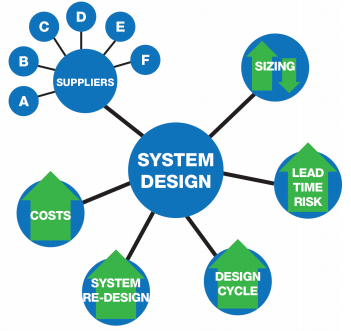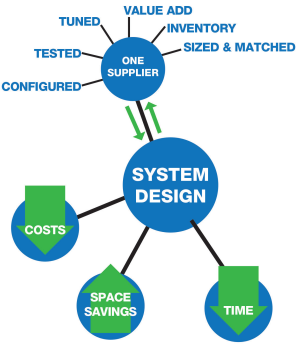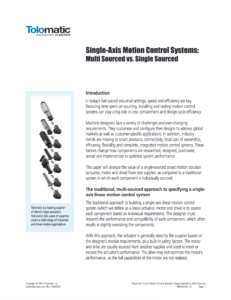Single-Axis Motion Control Systems: Multi Sourced vs. Single Sourced
Introduction
In today’s fast-paced industrial settings, speed and efficiency are key. Reducing time spent on sourcing, installing and testing motion control systems can play a big role in cost containment and design cycle efficiency.
Machine designers face a variety of challenges and ever-changing requirements. They customize and configure their designs to address global markets as well as customer-specific applications. In addition, industry trends are moving to smart products, connectivity, total cost of ownership, efficiency, flexibility and complete, integrated motion control systems. These factors change how components are researched, designed, purchased, tested and implemented to optimize system performance.
This paper will analyze the value of a single-sourced smart motion solution (actuator, motor and drive) from one supplier, as compared to a traditional system in which each component is individually sourced.
The traditional, multi-sourced approach to specifying a single-axis linear motion control system
The traditional approach to building a single-axis linear motion control system (which we define as a linear actuator, motor and drive) is to source each component based on individual requirements. The designer must research the performance and compatibility of each component, which often results in slightly oversizing the components.
With this approach, the actuator is generally sized by the supplier based on the designer’s motion requirements, plus built-in safety factors. The motor and drive are usually sourced from another supplier and sized to meet or exceed the actuator’s performance. The drive may not optimize the motor’s performance, so the full capabilities of the motor are not realized.
This approach results in design inefficiencies in performance, and slows the design process by requiring information transfer between multiple suppliers. Additionally, the designer has to coordinate each supplier’s sizing activities to ensure that final system performance will meet machine and design requirements.
System design and integration considerations
Ensuring that the actuator and motor work together reliably may require considerable testing. The traditional component-sourced approach, can compromise system reliability because components may not be designed and tested together for optimal performance.
In many cases, the motor is not sized specifically for the actuator’s performance (i.e., bearing systems, screw or belt, couplings and timing belts). For example, the motor may be capable of suppling more torque than the actuator’s coupling system is designed for or its speed (RPM) capabilities could be more than the linear actuator screw assembly’s capabilities. Either scenario may result in undesired performance, such as cogging belts, premature wear or critical speed (screw whip) issues.
Matching the motor, drive, couplings and actuator to one another ensures that one portion of the mechanical system does not over-drive another with torques, forces or speeds. If components are not matched, a user can inadvertently over-drive the mechanical components, causing damage, premature failure or unforeseen problems in the application design.
As the number of components and suppliers involved increases, so do the risks to machine design completion and project delivery. Multiple components shipping from multiple suppliers risks delaying the entire project schedule. Each of the multiple components in the system is susceptible to supplier design changes, which can require refitting and performance evaluation of components and the entire system.
Multiple suppliers and components can also increase technical issues. Organizational costs and supply chain complexities increase as well. Multiple suppliers can increase startup and installation time to ensure that components run smoothly with each other.
Issues with Traditional Multi-Sourced Systems

A single-sourced, complete single-axis linear motion control system
A single-sourced, single-axis linear motion system also consists of a linear actuator, motor and drive. However, in this case, one supplier delivers the system and the key components needed to generate linear motion in a single axis. The actuator can be combined with an integrated servo motor/drive/ controller for all-in-one smart actuator control.
This approach solves many of the multi-sourced approach’s challenges. Sourcing a complete linear motion solution from a single supplier reduces the number of unique components in the machine/system, allowing for a streamlined sourcing approach and minimizing the risk of shipment delays that impact delivery and start date schedules.
This streamlined approach of working with a one-solution supplier saves engineers design time and resources, because the individual components are sized and matched to one another to ensure system performance requirements are met. Valuable design time and technical resources are not required to interface with multiple suppliers.
This approach also fosters greater designer/supplier collaboration throughout the design process, allowing the supplier to add value throughout the design phases of the project. The supplier sizes, configures, tunes and factory-tests the complete linear motion system to ensure smooth operation during integration and startup. This also improves system reliability because components are matched to the system and extensive testing is done at the supplier.
In contrast to the traditional multi-sourced linear motion system approach, the single-sourced approach has a streamlined process for more efficient collaboration between designers and suppliers. The single-sourced approach reduces the design cycle and resources required to source a linear motion solution.
Modular platform allows for system flexibility
Single-sourced, single-axis, linear motion solutions can be modular. One integrated servo motor and drive can be paired with numerous actuator platforms to match the machine or system design. Configurable actuators and motors allow the designer to change length, mounting options and Ethernet communication protocols easily between machines without the need to redesign an entire motion system.

The flexibility of a modular system solution and the benefit of receiving a motion system pre-configured and pre-tuned from the supplier are essential for OEMs serving global markets. Mass customization is growing, as is the need for configurations that allow machine modifications for customer requirements. Both trends need flexible, modular, single-axis linear motion systems.
A flexible, single-axis linear motion platform allows machine designers to choose between a variety of Ethernet communication protocols based on customer or machine design requirements. A key part of the solution is a servo motor with integrated drive. The integrated servo motor/drive/ controller improves communication and connectivity with the motion system. Status updates can be built into the system architecture to increase overall system connectivity and monitoring.
A traditional servo motor requires a separate drive mounted and wired in a controls cabinet. However, a servo motor with an integrated drive and controller saves cabinet space and reduces wiring issues. The resulting integrated smart actuator approach saves system costs – by reducing machine size, wiring and set-up/integration times.
The modular approach of an integrated, smart actuator system also reduces the total cost of ownership to the customer and machine builder. The same motor with integrated drive can be mounted to multiple smart actuator configurations when projects require spare motion systems to be stocked. A customer can stock one type of motor/drive assembly that configures to work with any smart actuator configuration. This flexibility reduces the number of complete systems that must be stocked as replacement parts and optimizes company-owned inventory. The value of a single-sourced, modular, integrated smart linear motion system lies not only in solving issues that arise from traditional multi-sourced systems but also in providing additional benefits in the design, integration and operation of the machine.
Advantages of Single-Sourced Systems

Application example of a single-sourced, smart linear motion solution
A packaging equipment OEM designing equipment for global marketplace required frequent customization due to customer products and packaging methods. The OEM had worked with several suppliers to specify actuators, motors and drives for each machine. As the requirements for each machine changed, so did the linear motion requirements. The OEM had to invest time to re-specify, source, test and tune the complete linear motion system. Project schedules were impacted as components sourced from multiple suppliers had varying lead times. Often one component would experience delays and increase lead times for the entire project.
To address these issues, the OEM evaluated and implemented a single-sourced, integrated, smart linear motion system. The flexibility of the integrated servo motor/drive/controller and the actuators allowed the OEM to easily modify stroke lengths or mounting options to fit each machine modification.
This new platform also saved engineering time since multiple components no longer needed to be evaluated and specified. The supplier’s completely factory-tested solution reduced OEM design cycle time because it performed to system design requirements.
The smart actuation solution’s servo motor with integrated drive saved the OEM cabinet space as well as wiring and integration time. The motor supported multiple Ethernet protocols so the OEM could be flexible with control system specifications.
The single-sourced, integrated, smart actuation system solved the lead time problems the OEM experienced when sourcing through multiple suppliers. When the entire process was evaluated, the OEM saw improvements in efficiencies, including time savings during the design cycle and system integration. These increased efficiencies helped the OEM reduce costs.
Conclusion
As industrial markets change, it is important to re-evaluate motion control selection processes. Using a single-sourced, integrated smart actuation system addresses issues associated with a traditional multi-sourced approach. A single-sourced, integrated smart actuation solution also can improve overall design cycle efficiency and system reliability.

 Ask an Engineer
Ask an Engineer